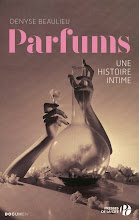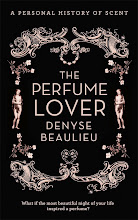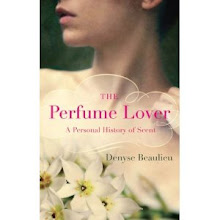“It was a dinner at Olivier
Roellinger’s in Cancale some ten years ago that convinced me once and for all
that cuisine could be something else than a craft or a pleasant moment; that it
could elicit complex impressions, feelings and thoughts. That it could foster
reflections based on emotions, which had seemed to me to be the prerogative of
art… Roellinger articulated the scenario of his menu around the history of his
terroir, the region of Saint-Malo: the spice roads, the mores of corsairs,
local products. The succession of dishes was a genuine analytical narrative of
his immediate environment.”
The above is an excerpt from the catalogue of Cookbook, Art and Culinary Process, an exhibition curated by Nicolas
Bourriaud at the Paris École des Beaux-arts. In it, he explains, culinary art is
put “to the test of the exhibition space”:
a fascinating exercise to study when you’re reflecting on a way to put perfume
to a similar test. I’ve always found Bourriaud, who is an old friend, receptive
to my musings on the matter. In his essay, he draws a comparison between the
perception of film prior to the Cahiers
du Cinéma’s politics of the auteur,
and the current artistic status of, respectively, cuisine and perfumery. Cuisine, he writes, “is not yet thought about in aesthetic terms because it is perceived
like cinema used to be, as an industry, a leisure activity and a craft.”
It’s a line of reasoning I’ve also applied to perfume in my book, and developed
further in the French version.
Cuisine has had its auteurs since the 1980s, as the maverick food critic Andrea Petrini
points out in another essay of the Cookbook
catalogue: “artist-chefs” like Pierre Gagnaire, Alain Passard, Marc Veyrat and
Olivier Roellinger, who developed not only an intensely self-referential stylistic
vocabulary, but also increasingly elaborate narratives about their terroir and even a “theoretical”
discourse. Like contemporary artists, this generation of chefs knew their work
would “sell” better if it came with its own commentary.
In this respect, chefs are decades ahead of perfumers
(staking a claim to the auteur status
is much more easily accomplished when you’re your own boss). One of the few
perfumers who’s actually managed to earn a similar position is Jean-Claude
Ellena. Hermès has afforded him enough artistic freedom to cultivate his own
style – indeed, Ellena’s self-referentiality is a key element of Hermès’s
olfactive branding strategy. He has framed his approach within a narrative,
both in his own books and in Chandler Burr’s The Perfect Scent. He’s exposed his theory of perfume composition,
and his body of work has generated a critical apparatus – surely there has
never been a perfumer whose oeuvre lent itself better to the exercise, since he
himself delivers the keys to understand it (you could also say, conversely,
that his prose is so limpid it short-circuits critical discourse: what can you
say after it?).
Both Jean-Claude Ellena and Olivier Roellinger
therefore have similar statuses in and approaches to their respective fields,
straddling the gap between art and perfumery/cuisine. People who knew them both
were convinced they’d get along marvelously. And they were right: their meeting
yielded a genuine bromance, which in turn gave birth to the latest Hermessence,
Épice Marine.
The scent was inspired by the chef’s work: his
particular way of combining the produce of his native Brittany with the spices
his corsair ancestors brought back from all over the world. It was elaborated
as an exchange between the two friends, Roellinger supplying suggestions and
testing the mods. Ellena seldom mentions raw materials when he presents his new
compositions, but in this case he does, since the different elements appeared
over the course of their conversations and correspondence – Roellinger, who had
to forego the pressures of working as a starred Michelin chef after a major
health issue, he still creates spice blends and travels the world to source his
materials, another crossover between the chef/in-house perfumer narratives.
“Narrative” is the key word here. In Épices & Roellinger, the “corsair
chef” unfolds the wonderful stories that led to his conceiving each of his
spice blends: his accords are dictated not only by their formal qualities, but
by the history of spice roads, explorers and corsairs, and by Roellinger’s own
stories – his roots in Brittany, his seafaring ancestors, his trips. I remember
thinking, while reading the book, that all of these could be about perfumes.
That this was the way perfumes should be created. Not only Roellinger’s stories
authenticate his blends, which comes
off as somehow more genuine that most perfume backstories since he can fully sign them, but they add an extra
dimension to them. You’re not only eating something delicious; you’re aware of
savoring a history, interpreted by contemporary mind.
Though Ellena has often exposed the process behind his
compositions, it is also the first time he supplies a journal with the press
material: an extension of his parallel career as a writer. More than in any
previous composition, this story is part of the perfume. In fact, Roellinger
himself is the most significant ingredient of Épice Marine.
“Culinary stylistics cannot rest solely on the
gustatory value of a dish”, Nicolas
Bourriaud writes in Cookbook. “Its mode
of production, its visual, tactile or semiotic dimensions, as well as its mode
of consumption and the type of conviviality it generates, must also be taken
into account to establish the bases of a specific aesthetics.”
In the same way, perfume is not solely an olfactive
form. Increasingly, brands go beyond the commercial setting and packaging to
script the “mode of consumption” of a fragrance by displaying its “mode of
composition”. They show the author and the process, an approach reminiscent of
today’s open kitchens in restaurants. The most auteur-oriented brands have also been supplying texts –Serge Lutens’ cryptic prose and
Jean-Claude Ellena’s limpid journals being the most significant. Not press
releases, which marketing services usually put together according to a format
so strictly coded they end up saying nothing except their press-release-ness. But
an integral part of the work, without which it would lose part of its effects
and resonance. In this case, the story
of the development of the fragrance is embedded into the story of the two men’s
friendship, in turn embedded into their respective stories. A double mise en abyme – the French term for
“reflexive embedding”, such as a play within a play, could be literally translated as “put into
the abyss”. An apt term for a scent named after and inspired by the sea, with a
marine note.
Now, does Épice
Marine – the actual scent – live up to its story? First off,
in case that “marine” bit got you worried: no, this is most emphatically not an
aquatic. Not a cucurbit in sight. The marine note is supplied by an old
synthetic called algenone, which Ellena describes as “green, lively, biting and
salty”, smelling of algae (obviously) but also of “lilac green”.
Of course, this would be quintessential Ellena:
utterly delicate, fresh, woody, ethereal. An overdose of bergamot stands for the
bracing quality of the Atlantic wind, carrying a slightly nose-tingling whiff
of his “oceanic spice bouquet” – Sichuan
pepper, Jamaican pimento, cardamom and a roasted cumin, a treatment of the
spice Roellinger introduced to Ellena, which rids it of its sweaty facets and
adds a roasted sesame seed facet. The spices introduce woody-smoky notes centered
on Islay whisky (more specifically, Bruichladdich, which Roellinger suggested).
But again, this isn’t a full-on boozy note: rather the impression you could get
from sipping from a glass whose inside had been sprayed with the whisky. A
subliminal suggestion of whisky, softly smoky, peaty and iodic[1].
Over the dinner following the private view of Cookbook, I spoke with Massimo Bottura,
the chef and owner of the Osteria Francescana in Modena, who “seasons” his “Give
Me a Hen not Roasted” dish with a distillation of roasted guinea fowl (this is
done to avoid over-cooking, and thus drying the breast while giving it a “fresh
out of grandma’s oven” aroma). Bottura’s distillation is the ghost of the nonna: as he dissociates, transforms and
reassembles his cooking materials in a novel way, he is also very deliberately
using memory and stories as ingredients. A scent like Épice Marine reads like the ghost of a luncheon in the pine grove
beside Roellinger’s Maisons de Bricourt, with the milky-opalescent, slate and
aquamarine-streaked sky and seascape of the Baie du Mont Saint-Michel as a
backdrop…
I’d love to conclude these musings with a blindingly
insightful comment, but I think this is just a start on a train of thought
about perfume, cuisine and art. Besides, it’s got me working up an appetite.
Oct. 18th 2013 – Jan. 9th 2014
Palais des Beaux-Arts
13, quai Malaquais, 75006 Paris
Open Tuesday to Sunday from 1 to 7 p.m.
Admission: 7.50€
Illustration: Untitled Peinture de feu by Yves Klein, 1962 (not shown in the exhibition, just my pick, though since it's about burning it does have something to do with cuisine).
[1] In his journal, Ellena gives elements of this whisky
accord: nerolidol, orivone (an iris-woody-camphoraceous-earthy molecule), birch
tar, a trace of absinth and rum, phenyl ethylic alcohol.


.jpg)




 L'actu
L'actu 

